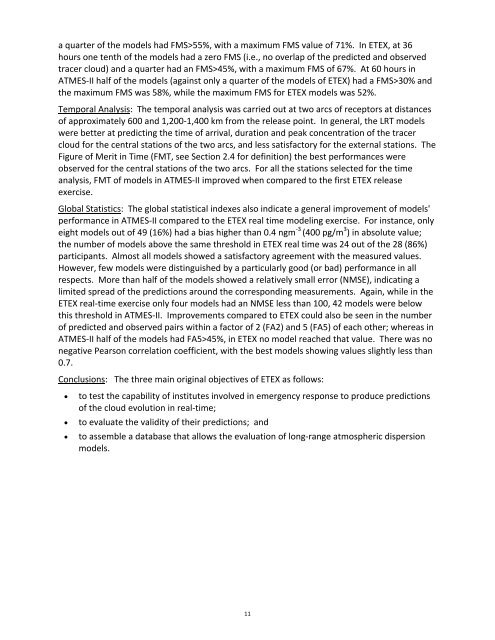Documentation of the Evaluation of CALPUFF and Other Long ...
Documentation of the Evaluation of CALPUFF and Other Long ...
Documentation of the Evaluation of CALPUFF and Other Long ...
Create successful ePaper yourself
Turn your PDF publications into a flip-book with our unique Google optimized e-Paper software.
a quarter <strong>of</strong> <strong>the</strong> models had FMS>55%, with a maximum FMS value <strong>of</strong> 71%. In ETEX, at 36<br />
hours one tenth <strong>of</strong> <strong>the</strong> models had a zero FMS (i.e., no overlap <strong>of</strong> <strong>the</strong> predicted <strong>and</strong> observed<br />
tracer cloud) <strong>and</strong> a quarter had an FMS>45%, with a maximum FMS <strong>of</strong> 67%. At 60 hours in<br />
ATMES‐II half <strong>of</strong> <strong>the</strong> models (against only a quarter <strong>of</strong> <strong>the</strong> models <strong>of</strong> ETEX) had a FMS>30% <strong>and</strong><br />
<strong>the</strong> maximum FMS was 58%, while <strong>the</strong> maximum FMS for ETEX models was 52%.<br />
Temporal Analysis: The temporal analysis was carried out at two arcs <strong>of</strong> receptors at distances<br />
<strong>of</strong> approximately 600 <strong>and</strong> 1,200‐1,400 km from <strong>the</strong> release point. In general, <strong>the</strong> LRT models<br />
were better at predicting <strong>the</strong> time <strong>of</strong> arrival, duration <strong>and</strong> peak concentration <strong>of</strong> <strong>the</strong> tracer<br />
cloud for <strong>the</strong> central stations <strong>of</strong> <strong>the</strong> two arcs, <strong>and</strong> less satisfactory for <strong>the</strong> external stations. The<br />
Figure <strong>of</strong> Merit in Time (FMT, see Section 2.4 for definition) <strong>the</strong> best performances were<br />
observed for <strong>the</strong> central stations <strong>of</strong> <strong>the</strong> two arcs. For all <strong>the</strong> stations selected for <strong>the</strong> time<br />
analysis, FMT <strong>of</strong> models in ATMES‐II improved when compared to <strong>the</strong> first ETEX release<br />
exercise.<br />
Global Statistics: The global statistical indexes also indicate a general improvement <strong>of</strong> models'<br />
performance in ATMES‐II compared to <strong>the</strong> ETEX real time modeling exercise. For instance, only<br />
eight models out <strong>of</strong> 49 (16%) had a bias higher than 0.4 ngm ‐3 (400 pg/m 3 ) in absolute value;<br />
<strong>the</strong> number <strong>of</strong> models above <strong>the</strong> same threshold in ETEX real time was 24 out <strong>of</strong> <strong>the</strong> 28 (86%)<br />
participants. Almost all models showed a satisfactory agreement with <strong>the</strong> measured values.<br />
However, few models were distinguished by a particularly good (or bad) performance in all<br />
respects. More than half <strong>of</strong> <strong>the</strong> models showed a relatively small error (NMSE), indicating a<br />
limited spread <strong>of</strong> <strong>the</strong> predictions around <strong>the</strong> corresponding measurements. Again, while in <strong>the</strong><br />
ETEX real‐time exercise only four models had an NMSE less than 100, 42 models were below<br />
this threshold in ATMES‐II. Improvements compared to ETEX could also be seen in <strong>the</strong> number<br />
<strong>of</strong> predicted <strong>and</strong> observed pairs within a factor <strong>of</strong> 2 (FA2) <strong>and</strong> 5 (FA5) <strong>of</strong> each o<strong>the</strong>r; whereas in<br />
ATMES‐II half <strong>of</strong> <strong>the</strong> models had FA5>45%, in ETEX no model reached that value. There was no<br />
negative Pearson correlation coefficient, with <strong>the</strong> best models showing values slightly less than<br />
0.7.<br />
Conclusions: The three main original objectives <strong>of</strong> ETEX as follows:<br />
• to test <strong>the</strong> capability <strong>of</strong> institutes involved in emergency response to produce predictions<br />
<strong>of</strong> <strong>the</strong> cloud evolution in real‐time;<br />
• to evaluate <strong>the</strong> validity <strong>of</strong> <strong>the</strong>ir predictions; <strong>and</strong><br />
• to assemble a database that allows <strong>the</strong> evaluation <strong>of</strong> long‐range atmospheric dispersion<br />
models.<br />
11

















